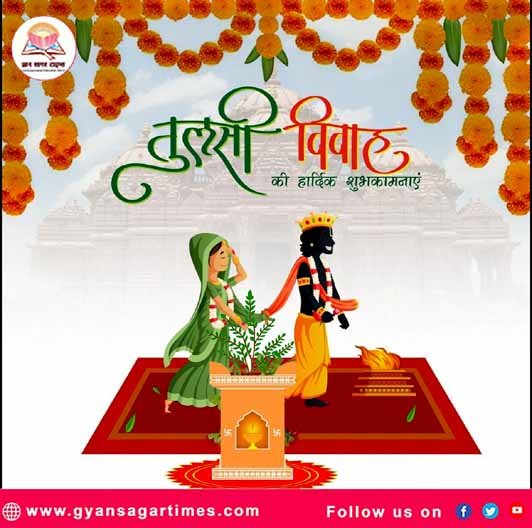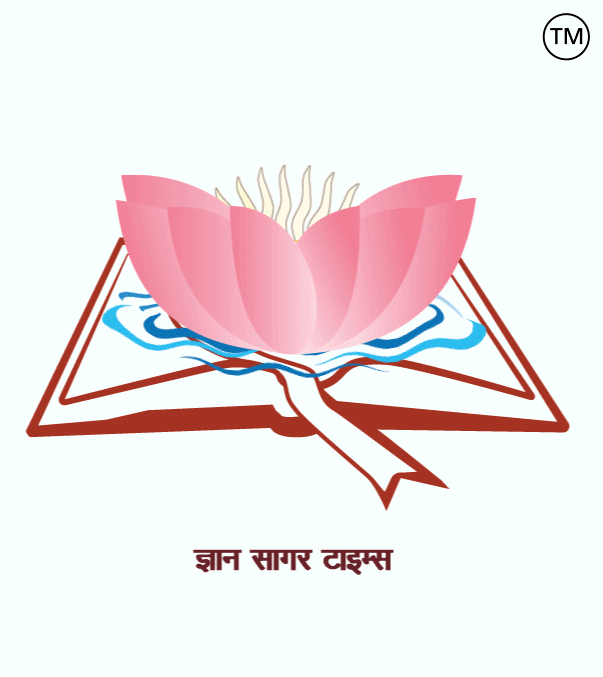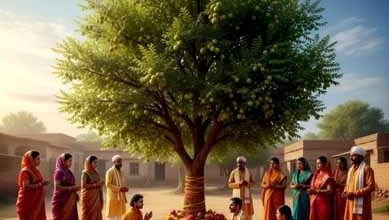
तुलसी विवाह…
तुलसी विवाह सनातन धर्म का एक अत्यंत पावन और भावनात्मक पर्व है, जो न केवल धार्मिक आस्था का प्रतीक है बल्कि, भारतीय संस्कृति में प्रकृति पूजन और सामाजिक समरसता की गहराई को भी दर्शाता है. यह पर्व हर वर्ष कार्तिक मास के शुक्ल पक्ष की द्वादशी तिथि को मनाया जाता है. जबकि, कार्तिक मास के शुक्ल पक्ष की एकादशी को हरी प्रबोधिनी एकादशी मनाई जाती है.
यह एक प्रतीकात्मक विवाह समारोह है, जिसमें औषधीय गुणों से भरपूर तुलसी (वृंदा) के पौधे का विवाह भगवान विष्णु के एक स्वरूप शालिग्राम से किया जाता है. यह उत्सव चातुर्मास की समाप्ति और सभी मांगलिक कार्यों, जैसे विवाह, मुंडन आदि के आरंभ का भी प्रतीक होता है.
सनातन धर्म में तुलसी के पौधे को अत्यंत पवित्र और पूजनीय माना जाता है. इसे साक्षात देवी लक्ष्मी का स्वरूप माना गया है, और भगवान विष्णु को तुलसी अत्यंत प्रिय हैं. तुलसी विवाह का पर्व कई कारण है उनमें – भगवान विष्णु के चार महीने की योगनिद्रा (चातुर्मास) से जागने के बाद होता है, जिसे देवउठनी एकादशी कहते हैं. इसके अगले दिन तुलसी विवाह के साथ ही विवाह, गृह प्रवेश और अन्य सभी शुभ कार्य पुनः शुरू हो जाते हैं. पौराणिक मान्यताओं के अनुसार, कोई भक्त विधि-विधान से तुलसी और शालिग्राम का विवाह कराते हैं, उन्हें कन्यादान के समान महान पुण्य फल प्राप्त होता है.
इस विवाह को कराने से वैवाहिक जीवन में प्रेम, सुख, स्थिरता और खुशहाली आती है. अविवाहितों के लिए शीघ्र विवाह के योग बनते हैं और विवाह संबंधी अड़चनें दूर होती हैं. तुलसी विवाह के दिन तुलसी पूजन और विवाह कराने से जीवन के सभी कष्ट दूर होते हैं और पापों का शमन होता है.
विधि और परंपरा: –
सर्वप्रथम घर या मंदिर में तुलसी के पौधे को मंडप में सजाया जाता है. उसे चूड़ी, चुनरी, साड़ी, सिंदूर आदि से श्रृंगारित किया जाता है. उसके बाद भगवान विष्णु के शालिग्राम स्वरूप को तुलसी के पास रखा जाता है और विवाह की विधि पूरी श्रद्धा से संपन्न की जाती है. इस दौरान विवाह गीत, मंगल आरती, और प्रसाद वितरण के साथ यह उत्सव सामूहिक रूप से मनाया जाता है.
कथा: –
यह कथा जालंधर नामक एक अत्यंत बलशाली असुर और उसकी पतिव्रता पत्नी वृंदा से जुड़ी हुई है. राक्षसराज जालंधर को अपनी पत्नी वृंदा के सतीत्व के कारण अमरता का वरदान प्राप्त था. कोई भी देवता या मनुष्य उसे पराजित नहीं कर सकता था, जब तक वृंदा का सतीत्व भंग न हो जाए.
जालंधर के अत्याचारों से तंग आकर सभी देवता भगवान विष्णु के पास सहायता के लिए पहुँचे. भगवान विष्णु ने सृष्टि की रक्षा के लिए छल का सहारा लिया. उन्होंने जालंधर का रूप धारण किया और वृंदा के पास पहुँचे. वृंदा उन्हें अपना पति समझकर स्पर्श कर बैठी, जिससे उनका पतिव्रता धर्म टूट गया और जालंधर की शक्तियां समाप्त हो गईं.
जब वृंदा को इस छल का पता चला, तो वे अत्यंत क्रोधित हुईं और उन्होंने भगवान विष्णु को पत्थर बन जाने का श्राप दे दिया. इसी श्राप के कारण भगवान विष्णु ने शालिग्राम (पत्थर का रूप) का स्वरूप धारण किया. इसके बाद वृंदा अपने पति के साथ सती हो गईं. जिस स्थान पर वृंदा सती हुईं, वहाँ एक पौधा उग आया. भगवान विष्णु ने वृंदा की भक्ति से प्रसन्न होकर उन्हें वरदान दिया कि तुम तुलसी के नाम से विख्यात होगी और मुझे (शालिग्राम को) लक्ष्मी से भी अधिक प्रिय होगी. उन्होंने यह भी कहा कि अब तुम्हारा विवाह हर वर्ष मेरे शालिग्राम स्वरूप से होगा.
तुलसी विवाह प्रकृति के साथ मानवीय संबंधों को पुनः स्मरण कराने वाला पर्व है. यह दर्शाता है कि प्रकृति भी पूजनीय है, और उसके साथ हमारा संबंध केवल उपयोग का नहीं, बल्कि सम्मान और प्रेम का होना चाहिए. तुलसी विवाह केवल एक धार्मिक अनुष्ठान नहीं, बल्कि प्रेम, त्याग और पुनरुत्थान की कथा है. वृंदा का त्याग, विष्णु का पश्चाताप, और प्रकृति के साथ पुनः एकात्मता—यह सब हमें यह सिखाता है कि सच्चा धर्म केवल पूजा नहीं, बल्कि संवेदना और समरसता है.
=========== ========== ==========
Tulsi Vivah…

Tulsi Vivah is an extremely sacred and emotional festival of Sanatan Dharma, which is not only a symbol of religious faith but also reflects the depth of nature worship and social harmony in Indian culture. This festival is celebrated every year on the Dwadashi (twelfth day) of the Shukla Paksha (bright half) of the Kartik month. The day before, on the Ekadashi (eleventh day) of the Shukla Paksha of Kartik month, Hari Prabodhini Ekadashi is celebrated.
It is a symbolic marriage ceremony in which the Tulsi (Vrinda) plant, which is rich in medicinal properties, is married to Shaligram, a form of Lord Vishnu. This festival also marks the end of Chaturmas and the beginning of all auspicious activities such as marriages, mundan (first haircut ceremony), etc.
In Sanatan Dharma, the Tulsi plant is considered extremely sacred and revered. It is considered a form of Goddess Lakshmi herself, and Lord Vishnu is very fond of Tulsi. There are several reasons for celebrating Tulsi Vivah; one of them being that it takes place after Lord Vishnu awakens from his four-month yogic sleep (Chaturmas), which is called Devuthani Ekadashi. The day after, with Tulsi Vivah, marriages, housewarming ceremonies, and all other auspicious activities resume. According to mythological beliefs, a devotee who performs the marriage of Tulsi and Shaligram with proper rituals receives the great merit equivalent to Kanyadan (giving away one’s daughter in marriage).
Performing this marriage brings love, happiness, stability, and prosperity to married life. For unmarried people, it creates opportunities for early marriage and removes obstacles related to marriage. Performing Tulsi Puja and the marriage ceremony on the day of Tulsi Vivah removes all the troubles of life and atones for sins.
Rituals and Traditions: –
First, the Tulsi plant is decorated in a Mandap (canopy) at home or in a temple. It is adorned with bangles, a chunari (scarf), a saree, Sindoor (vermilion), etc. After that, the Shaligram form of Lord Vishnu is placed near the Tulsi plant, and the marriage ceremony is performed with complete devotion. During this time, the festival is celebrated collectively with wedding songs, Mangal Aarti (auspicious prayer), and distribution of prasad (offering).
Story: –
This story is associated with a very powerful demon named Jalandhara and his devoted wife, Vrinda. The demon king Jalandhara had received the boon of immortality due to his wife Vrinda’s chastity. No god or human could defeat him as long as Vrinda’s chastity remained intact.
Tired of Jalandhara’s atrocities, all the gods approached Lord Vishnu for help. Lord Vishnu resorted to deception to protect creation. He assumed Jalandhara’s form and went to Vrinda. Vrinda, mistaking him for her husband, touched him, thus breaking her vow of chastity, and Jalandhara’s powers were extinguished.
When Vrinda learned of this deception, she became extremely angry and cursed Lord Vishnu to turn into a stone. Because of this curse, Lord Vishnu assumed the form of a Shaligram (a stone). After this, Vrinda committed Sati (self-immolation) with her husband. A plant grew at the place where Vrinda committed Sati. Pleased with Vrinda’s devotion, Lord Vishnu blessed her, saying that she would be known as Tulsi and would be dearer to him (Shaligram) than even Lakshmi. He also said that her marriage would be celebrated every year with his Shaligram form.
Tulsi Vivah is a festival that reminds us of the human relationship with nature. It shows that nature is also worthy of worship, and our relationship with it should not be merely one of utility, but of respect and love. Tulsi Vivah is not just a religious ritual, but a story of love, sacrifice, and resurrection. Vrinda’s sacrifice, Vishnu’s repentance, and the renewed oneness with nature—all this teaches us that true religion is not just worship, but compassion and harmony.





